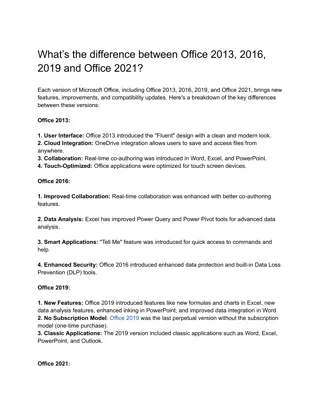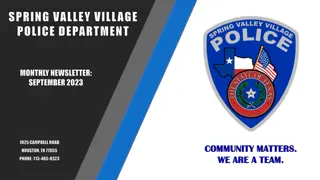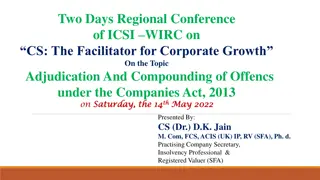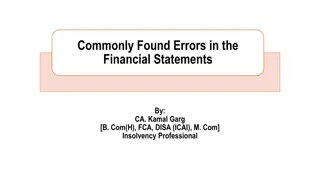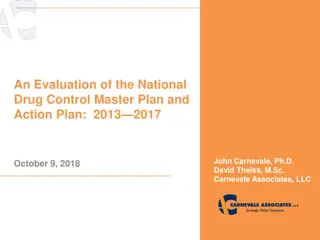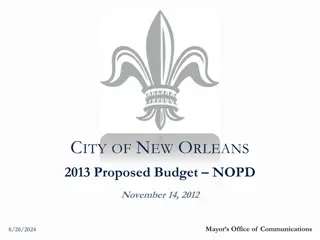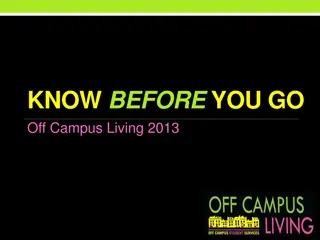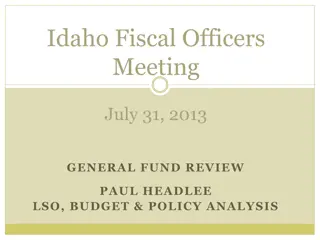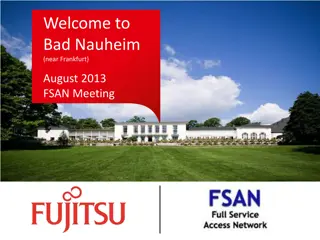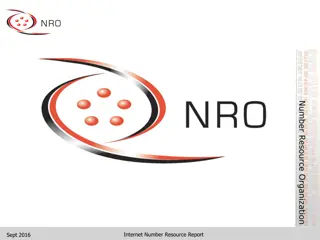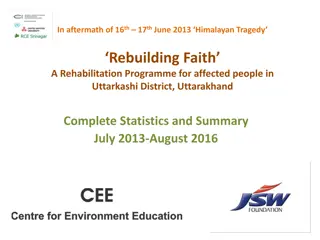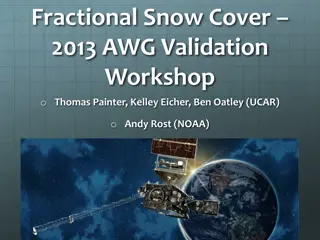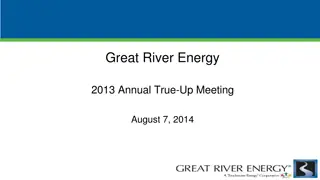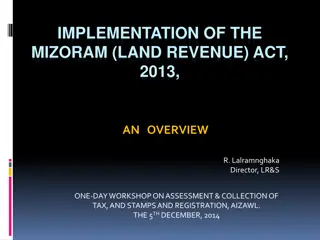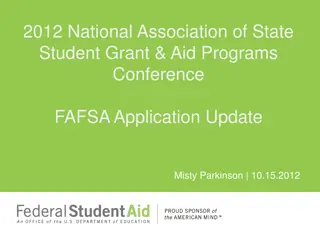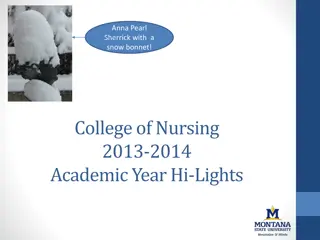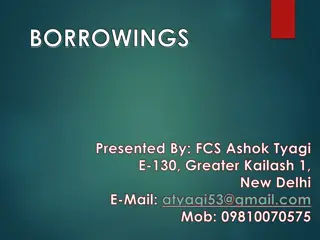
Travel Modelling Group Steering Committee Meeting Highlights
Explore the key discussions and updates from the Travel Modelling Group Steering Committee meeting, including progress on tools, network development, and the GTAModel Version 4.0. Discover advancements in model development and application tools, network optimization, microsimulation features, and the benefits of detailed trip-maker analysis.
Download Presentation

Please find below an Image/Link to download the presentation.
The content on the website is provided AS IS for your information and personal use only. It may not be sold, licensed, or shared on other websites without obtaining consent from the author. If you encounter any issues during the download, it is possible that the publisher has removed the file from their server.
You are allowed to download the files provided on this website for personal or commercial use, subject to the condition that they are used lawfully. All files are the property of their respective owners.
The content on the website is provided AS IS for your information and personal use only. It may not be sold, licensed, or shared on other websites without obtaining consent from the author.
E N D
Presentation Transcript
1 TRAVEL MODELLING GROUP STEERING COMMITTEE September 17, 2013
2 Today s Agenda 2001 / 2012 Base Network Progress Tools for model development and application GTAModel Version 4.0+ 2013/14 Work plan update 3-year funding model Other business
3 2011 / 2012 Network Progress For models based on the 2011 TTS* , a 2012 full-day network is being developed Draft base network (2012) is substantially completed, will be released for review this week. Where applicable, Google Transit Feed Specification (GTFS) is being used to generate 2012 transit data Network will consist of three major data components: Base network including ALL transit lines Network events file to define dynamic network changes (e.g., Jarvis reversible lane) Transit line departures file to define dynamic transit level-of- service * 2011 TTS is the agreed-on title for the most recent TTS, which includes data from both 2011 and 2012
4 Tools for Model Development and Application Several new tools have been added to the TMG Toolbox: Transit line boarding counts for comparison against TTS Zone adjacency matrix construction using zonal geometry Tool for deleting transit stops occurring on highways Tool for matching network rotation Network optimization tool converts cosmetic nodes to link shape vertices on a subset of links. Tools for comparing networks based on geometric similarity Additionally, the Network Package (*.nwp) format has been developed to facilitate the sharing and storing of Emme network data.
5 GTAMODEL V4.0
6 GTAModel V4 Key Features Microsimulation 24-hour weekday Continuous generation of activity/trip start times 4 (maybe 5?) time periods for network assignments AM Peak Mid-day PM Peak Evening/night (maybe split?) Based on 2011 TTS Activity/tour-based Same inputs as a 4-step model: Population & employment by zone Emme road and transit assignments to generate travel times/costs
7 Microsimulation Advantages: Processing a list of persons is faster than processing many large matrices. As soon as one starts to disaggregate trip-makers by occupation, age, etc. list-based calculations are far more efficient. Eliminates aggregation problems within the mode choice model Provides detailed distributions of behaviour and impacts by type of trip-maker (any type of aggregation of trips, etc. is possible). Simplifies model calculations.
8 24-Hour Modelling GTHA needs 24-hour modelling capability PM peak is now the dominant peak Energy/emissions calculations require 24-hour analysis Economic evaluation really requires 24-hour analysis Off-peak transit markets need to be analyzed.
9 Activity/Tour-Based Model It was originally proposed to build a simple tour-based model as a logical extension of current GTAModel and GGH Model practice (which effectively generate simple H-Work-H and H-School-H tours). In attempting to design this model, however, significant complications soon arose wrt modelling shopping and other-purpose trips in a simplified way (i.e., it quickly became not simple ). It also became clear that we already had a solution to this problem in the TASHA model that has been under development and testing at UofT for the past decade. We therefore propose to re-estimate TASHA using 2011 TTS data as the GTAModel 4.0 model system.
10 TASHA: Advantages Advantages of using TASHA include: Fully operational code already exists within XTMF, thereby minimizing the amount of new code that will need to be generated. TASHA deals with all trip purposes in a relatively simple, straightforward way but generates tours of arbitrary complexity in a computationally very efficient manner. Considerable experience with TASHA already exists that can be applied to the new version. We feel strongly that trying to invent a simple tour-based model represents an inferior solution and use of resources than a direct implementation of TASHA.
11 TASHA: Features Agent-based microsimulation; modelling both persons and households. 24Hour Activity Based weekday activity patterns Tour-based: tours are emergent out of the scheduling of out-of-home activities. Mode choice is tour-based. Arbitrarily complex tours can be generated and handled efficiently. Interfaces with both Emme and MATSIM (and, indeed, any network model).
12 TASHA: Features cont. Household-based: detailed auto availability & allocation models determine mode choice decisions. Model parameters can all be developed from TTS data (i.e., no special surveys are required). In addition to the Toronto implementation, TASHA has been applied for research purposes in Montreal, London UK and Changzhou China.
13 Activity Scheduling Project 1 episode 1.1 episode 1.2 . Project 2 episode 2.1 episode 2.2 . Project N episode N.1 episode N.2 . TASHA is an activity scheduling model in which individual activity episodes are generated and then explicitly scheduled. Out-of-home activity patterns and their associated trip-chains (tours) are thus built from scratch rather than selected from a pre-specified set of feasible patterns. Thus, travel patterns dynamically adjust to changes in transportation level of service, activity system supply , changes in household and personal constraints and needs, etc. Day 1 Day 2 Day 3 Day 4 Day 5 Day 6 Day 7
14 Joint Activities Person 1 Person 2 Day n Day n Joint Shopping Activity: Duration: 2 hrs Location: The Mall . . . . Search for feasible joint time slot
15 Vehicle Allocation within TASHA TASHA assigns household vehicles to drivers based on overall household utility derived from the vehicle usage. Drivers not allocated a car must take their second-best mode of travel. 3 Conflicting With-Car Chains 3 Conflicting With-Car Chains Person 1 Person 1 Work Work Shop Shop Person 2 Person 2 Shopping Shopping Person 3 Person 3 School School 3 Possible Vehicle Allocations 3 Possible Vehicle Allocations Person 1 Person 1 Person 2 Person 2 Person 3 Person 3 Allocation 1 Allocation 1 Choose allocation with highest total Choose allocation with highest total household utility household utility Allocation 2 Allocation 2 Allocation 3 Allocation 3
16 Tasha Passenger Mode On Tour Based Driver goes to the passenger Takes passenger to their destination Driver continues to their destination Home Based Driver starts from home Picks up passenger Takes passenger to their destination Returns home P O P O P D D O D D P D H
17 Tour-Based Mode Choice Tours are generated as a result of the generated activities for the individual. The selection of modes for the tour are done based upon the whole tour, however allowing for each trip to utilize a different mode. Provides accountability for auto usage. Can only use Auto if you drove the car from home. The car needs to come home at the end of the day.
18 Treatment of Time Models all out-of-home activities and trips for a 24-hour typical weekday To-the-second internal resolution Trips can be aggregated to whatever level of temporal detail/categorization is required by the network assignment model Deals naturally with peak-spreading , etc. Provides excellent detail for environmental impact analysis
19 Flexibility TASHA has been designed to be very flexible in terms of its development and its application. It has been developed using ordinary trip-based survey data for the GTA (but it could also exploit activity-based survey data). The data requirements for model development are no greater than other current models, including conventional trip-based models. It can be used as a direct replacement for the first 3 stages in a 4- step system, or integrated within a full microsimulation model system. Usable in a variety of contexts, and facilitates the evolution of the model system over time from aggregate to microsimulation.
20 Environmental Modeling with TASHA TASHA has been connected with: EMME/2 road & transit network assignment model (link speeds & volumes by hour of day) MOBILE6.2C emissions model (link emissions by type by link by time of day) CALMET meteorological model CALPUFF dispersion model (pollutant concentrations by zone by time of day) Dynamic population exposure to pollution by zone by time of day!!
21 Dispersion of Emission Concentrations
22 Dispersion of Emission Concentrations
23 Dispersion of Emission Concentrations
24 Current Status TASHA was developed using 1996 travel survey data for the GTHA. The activity scheduler has been validated against 2001 survey data. Interfaces with both EMME and MATSIM. TASHA has been used for several environmentally related studies in the GTHA. Has been applied in Montreal, London, Changzhou. Operational in XTMF
25 Implementing TASHA as GTAModel 4.0 TASHA assumes: Known work & school locations for all workers & students Known number of cars per household These models need to be added to TASHA (but would also have to be created for any V4.0 design) Will use: Doubly-constrained entropy PORPOW model (similar to GTAModel V2.0, V2.5 & GGH Model) Singly-constrained logit PORPOS model (similar to GGH Model) Simple logit household-based car ownership model
26 GTAModel V4.0 Tasks Models to estimate: Household auto ownership level PORPOW PORPOS Shopping episode location choice Other-purpose episode location choice Activity episode generation rates Tour-based mode choice model (including car allocation & ridesharing models jointly estimated)
27 Cloud Computing Earlier last week we successfully connected to the SOSCIP* cloud computing facility. This means that we can use the cloud to estimate the V4.0 models, greatly accelerating model estimation time. This will be particularly helpful for the tour-based mode choice models which are very computationally intensive to estimate. * Southern Ontario Super-Computing Innovation Platform. This is a joint venture of IBM Canada, Province of Ontario, Gov t of Canada and most southern Ontario universities (led by UofT and Western) to provide the most powerful computing facilities in Canada to Ontario researchers and industry.
28 THANK YOU!

